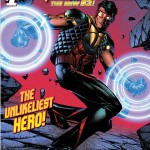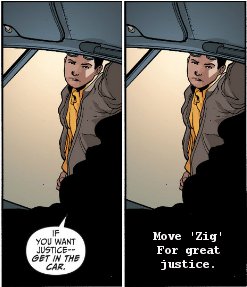 Vibe #1 drops into stores today and, if you’re like many of my LCS’s core demographic, you responded with a polite, “That’s nice”, blinked nonchalantly, and then went looking for Hellblazer #300 because you are a SERIOUS PERSON, GODDAMMIT and that the LAST REAL JOHN CONSTANTINE ISSUE before DC further neuters him and…went on to some post traumatic whimpering before finally pulling yourself together to look through the spoils of this week’s stack. Turns out, once you put your wailing and gnashing of teeth over the the Constantine thing aside and read Geoff Johns and Andrew Kreisburg’s Vibe, it’s actually pretty good.
Vibe #1 drops into stores today and, if you’re like many of my LCS’s core demographic, you responded with a polite, “That’s nice”, blinked nonchalantly, and then went looking for Hellblazer #300 because you are a SERIOUS PERSON, GODDAMMIT and that the LAST REAL JOHN CONSTANTINE ISSUE before DC further neuters him and…went on to some post traumatic whimpering before finally pulling yourself together to look through the spoils of this week’s stack. Turns out, once you put your wailing and gnashing of teeth over the the Constantine thing aside and read Geoff Johns and Andrew Kreisburg’s Vibe, it’s actually pretty good.
If you are like many casual, or perhaps not even so casual, comics readers, unless you were a fan of Justice League Detroit in the 80s your only real brush with Vibe was in cameos on the television show Justice League Unlimited and on Cartoon Network’s DC Nation shorts. Behold:
Yeah, you’d take that character seriously too. And, you wouldn’t be alone in your opinion. The original Vibe was killed off by J. M. DeMatteis to try and cap the end of the JLD era and George Pérez disliked Vibe so much that he refused to draw anything more than Vibe’s legs falling off a panel in the mega crossover JLA/Avengers – and Pérez knows a thing or two about teen superheroes.
So, why does this new iteration of Vibe work?
Warning – Ahead there be spoilers!
I don’t know why I should be so surprised, after all Johns has done yeoman’s work creating compelling storylines for B list characters, such as in Justice Society of America, Green Lantern, Aquaman, and even Billy Batson (you can’t make me call him Shazam. He’s Captain Marvel, damn it.). Johns, along with co-writer Andrew Kreisburg, has taken the formula that has worked for him on those books and applied it to Vibe to good effect. The book is character driven, making the readers interested in Francisco Ramon, the troubled young man from the streets of Detroit, far before they need to wonder about the super human vibration powers (and jokes that come with that) and goofy red and yellow costume.
In this new origin, young Francisco loses his oldest brother, Armando, when his brother tries to save him from an alien that arrives out of thin air on the day of Darkseid’s invasion of Earth five years previous. “Cisco” is caught in the wake of the alien being’s boom tube (Apokolips tech at its finest; accept no substitute!), which causes changes to his physiology and gives him his powers. In the five years that pass, Cisco’s other brother, Dante, develops a gambling problem and his father has gone to pieces. Cisco works at a local electronics store to save money so he can go to college like Armando would have wanted for him. In the meantime, he’s attracted the attention of Amanda Waller and the shadowy organization, A.R.G.U.S. – which still feels like DC’s answer to S.H.I.E.L.D. Turns out Cisco has been using his powers to stop crime in his neighborhood and his powers make it impossible for him to be caught on film. Ms. Waller likey. She sends one of her goons after Cisco with an offer to avenge Armando by joining the newly formed “Justice League Of America”:
While Johns and Kreisburg have put together an entertaining story, it is not entirely without its problems. The dark behind the scenes dealings between Waller and her goon as they talk about contingency plans for any of the kids A.R.G.U.S. is targeting are reminiscent of work Scott Lobdell already did with Superboy and the Teen Titans on the N.O.W.H.E.R.E. storyline. Waller’s agent describes the barrier between reality in Detroit and other dimensions as being a weak spot that can be breached by “parademons”, like the one that killed Armando. As a long time Buffy The Vampire Slayer fan, that just screams Hellmouth to me. And the writing team’s decision to remove Francisco from gang life in Detroit (the original Vibe, Paco Ramon, was in a street gang), with the hint of transferring elements of that to his brother Dante, takes away some grittiness that could have made Francisco that much more interesting. We’re left with a character that is not that different from the work John is already doing with Billy Batson – a young man in poor economic circumstance and a troubled family situation who comes into great power.
Pete Woods’s pencils in this issue are solid. His artwork is fluid and easy to follow. Action scenes have a good sense of movement and the character work is expressive. DC is still clinging to skinny Amanda Waller. She is my only quibble in this book, and that’s not his fault.
Overall, Vibe #1 might be my surprise find of the week. Johns and Kreisburg have collaborated to put together a plausible, engaging origin story for a character that generally did not get much serious treatment and respect, even when originally conceived by Gerry Conway. If the team can endeavor to avoid continuing to echo some previously established stories, it may just shape up to be something pretty fine.

 Podcast RSS Feed
Podcast RSS Feed iTunes
iTunes Google Play
Google Play Stitcher
Stitcher TuneIn Radio
TuneIn Radio Android
Android Miro Media Player
Miro Media Player Comics Podcast Network
Comics Podcast Network